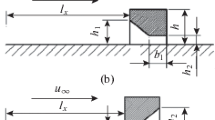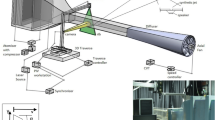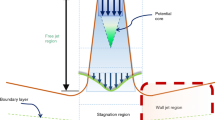Abstract
An experimental study of flow and heat transfer downstream of a surface-mounted rib with a slit is reported. The open area ratios of the slit rib considered are 10, 20, 30, 40 and 50% with respect to the total projected rib area. Experiments were conducted in a wind tunnel, mostly at a hydraulic diameter based Reynolds number of 32,100. The surface Nusselt number distribution was determined by liquid crystal thermography. Results show that the slit inside the rib enhances heat transfer and reduces pressure penalty, with an optimum performance seen at an open area ratio of 20%. To explain this result, a qualitative picture of the flow field behind the rib was obtained by smoke visualization. Time averages and turbulent statistics of the velocity and temperature fluctuations were measured in detail, using hotwire anemometry and cold wire anemometry respectively. For open area ratios less than 30%, measurements show that the flow through the slit modifies the reattaching shear layer from the top of the rib. The resulting reattachment length is smaller, the peak in Nusselt number is higher, and the average heat transfer from the heated surface is enhanced. For the rib with an open area ratio greater than 40%, the lower portion behaves as an independent small rib with its own reattachment region. Simultaneously, the flow downstream of the upper rectangular part shows characteristics of vortex shedding. Thus, the size of the slit is seen to be an additional parameter that can be used to control heat transfer from the solid surface, in comparison to the solid rib.











Similar content being viewed by others
Abbreviations
- e :
-
Rib height, m
- f :
-
Friction factor based on the pressure drop in the duct over the length of the test section
- L r :
-
Reattachment length
- Nu :
-
Span-wise averaged Nusselt number as a function of x
- \(\overline{{Nu}} \) :
-
Plate-averaged Nusselt number
- Re :
-
Reynolds number based on the hydraulic diameter of the duct and average velocity
- Re e :
-
Reynolds number based on the rib height and average velocity
- T(x, y):
-
Fluid temperature distribution, dimensionless
- u, v :
-
Local velocity components in Cartesian coordinates scaled by the duct-averaged velocity
- u′′, v’′:
-
Local velocity fluctuations in Cartesian coordinates scaled by the duct-averaged velocity
- \( - \overline{{{u}\ifmmode{'}\else$'$\fi{v}\ifmmode{'}\else$'$\fi}} \) :
-
Turbulent shear stress non-dimensionalized by the square of the average velocity
- U avg :
-
Duct-averaged velocity, m/s
- x, y:
-
Streamwise and wall normal coordinates respectively (Fig. 1)
- β :
-
Open area ratio, %
- δ :
-
Velocity boundary layer thickness, m
- δ T :
-
Thermal boundary layer thickness, m
- avg:
-
Average
- o:
-
Smooth passage
- rms:
-
Root mean square
- w:
-
Wall
- ∞:
-
Free stream
- +:
-
Wall coordinate
- ′:
-
Fluctuating quantity
References
Acharya S, Panigrahi PK (2003) Analysis of large scale structures in separated shear layers, experimental. Therm Fluid Sci 27(7):817–828
Acharya S, Dutta S, Myrum TA, Baker RS (1993) Periodically developed flow and heat transfer in a ribbed duct. Int J Heat Mass Transf 36:2069–2082
Aliaga DA, Lamb JP, Klein DE (1994) Convective heat transfer distributions over plates with square ribs from infrared thermography measurements. Int J Heat Mass Transf 40:363–374
Baughn JW (1995) Liquid crystal methods for studying turbulent heat transfer. Int J Heat Fluid Flow 16:365–375
Bruun HH (1994) Hot-wire anemometry. Oxford University Press, New York, pp 147–156
Cavallero D, Tanda G (2002) An experimental investigation of forced convection heat transfer in channels with rib turbulators by means of liquid crystal thermography. Exp Therm Fluid Sci 26:115–121
Chen TY, Du RK (2003) Effects of velocity fluctuations on heat transfer enhancement. Exp Fluids 34(5):548–555
Chyu MK, Natarajan V (1993) Effects of a slit in a rib on the heat transfer from a rib-mounted wall. Am Soc Mech Eng J Heat Transf 115:792–796
Ekkad SV, Han JC (1997) Detailed heat transfer distributions in two-pass square channels with rib turbulators. Int J Heat Mass Transf 40:2525–2537
Han JC, Zhang YM (1992) High performance heat transfer ducts with parallel, broken and V-shaped broken ribs. Int J Heat Mass Transf 35:513–523
Hinze JO (1979) Turbulence, 2nd edn. McGraw-Hill, New York, pp 83–174
Hirota M, Fujita H, Yokosawa H (1994) Experimental study on convective heat transfer for turbulent flow in a square duct with a ribbed rough wall (characteristics of mean temperature field). Am Soc Mech Eng J Heat Transf 116:332–340
Hwang JJ (1998) Heat transfer-friction characteristic comparison in rectangular ducts with slit and solid ribs mounted on one wall. Am Soc Mech Eng J Heat Transf 120:709–716
Kays WM, Crawford ME (1993) Convective heat and mass transfer. McGraw-Hill, New York
Kukreja RT, Lau SC, McMillin RD (1993) Local heat/mass transfer distribution in a square channel with full and V-shaped ribs. Int J Heat Mass Transf 36:2013–2020
Launder BE (1988) On the computation of heat transfer in complex turbulent flows. Am Soc Mech Eng J Heat Transf 110:1112–1128
Liou T-M, Chang Y, Hwang D-W (1990) Experimental and computational study of turbulent flows in a channel with two pairs of turbulence promoters in tandem. Am Soc Mech Eng J Heat Transf 112:302–310
Liou T, Wang W, Chang Y (1995) Holographic interferometry study of spatially periodic heat transfer in a channel with ribs detached from one wall. Am Soc Mech Eng J Heat Transf 117:32–38
Mochizuki S, Murata A, Shibata R, Yang WJ (1999) Detailed measurement of local heat transfer coefficients in turbulent flow through smooth and rib-roughened serpentine passages with a 180° sharp bend. Int J Heat Mass Transf 42:1925–1934
Okajima A (1982) Strouhal numbers of rectangular cylinders. J Fluid Mech 123:379–398
Panigrahi PK, Acharya S (1999) Mechanisms of flow transport in a turbine blade coolant passage of a rib-turbulator. Am Soc Mech Eng J Turbomach 121:152–159
Panigrahi PK, Acharya S (2004) Multi-modal forcing of the turbulent separated shear flow past a rib. Am Soc Mech Eng J Fluids Eng 126:22–31
Panigrahi PK, Tariq A (2003) Liquid crystal heat transfer measurements in a rectangular channel with solid and slit rib. J Flow Vis 6:407–416
Schlichting H (1979) Boundary layer theory, 7th edn. McGraw-Hill, New York, pp 564–570
Sparrow EM, Tao WQ (1983) Enhanced heat transfer in a flat rectangular duct with streamwise-periodic disturbances at one principal wall. Am Soc Mech Eng J Heat Transf 105:851–861
Swaminathan MK, Rankin GW, Sridhar K (1986), Evaluation of the basic systems of equations for turbulence measurements using the Monte Carlo method. J Fluid Mechanics 170:1–19
Tariq A, Panigrahi PK (2003) Flow and heat transfer in a rectangular duct with single-rib and two-ribs mounted on the bottom surface. J Enhanced Heat Transf 10:171–198
Torii K, Nishino K, Nakatama K (1994) Mechanism of heat transfer augmentation by longitudinal vortices in a flat plate boundary layer. In: Proc 10th Int Heat Transf Conf, Brighton, UK 6:123–128
Author information
Authors and Affiliations
Corresponding author
Rights and permissions
About this article
Cite this article
Tariq, A., Panigrahi, P.K. & Muralidhar, K. Flow and heat transfer in the wake of a surface-mounted rib with a slit. Exp Fluids 37, 701–719 (2004). https://doi.org/10.1007/s00348-004-0861-8
Received:
Accepted:
Published:
Issue Date:
DOI: https://doi.org/10.1007/s00348-004-0861-8





